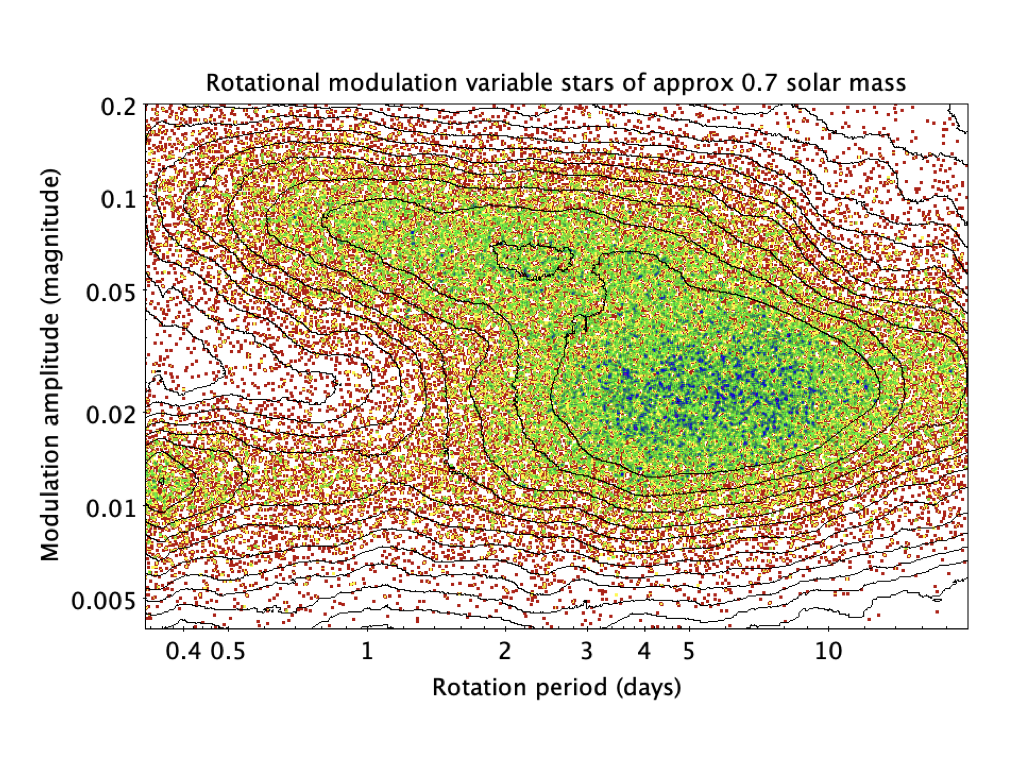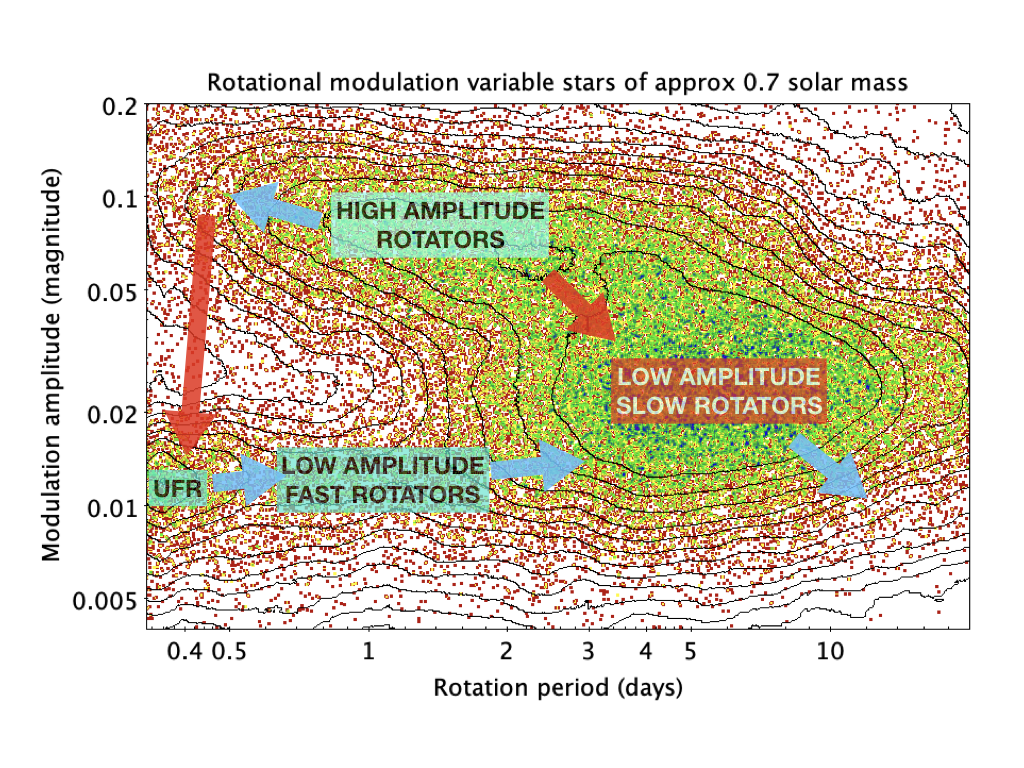Evidence of new magnetic transitions in late-type dwarfs from Gaia DR2

Since the second Gaia data release on the 25th April 2018, astrophysicists have at their disposal an unprecedented wealth of information not only on distances and motions of stars in our Galaxy, but also on many other stellar parameters that came along by exploiting the instrumentation aboard the satellite and the unique characteristics of the mission. Multiple observations of the same star, required to derive its distance and motion, also produced parameters related to stellar variability. Data for stars with spots on the surface similar to those on our Sun, in particular, provide information on their rotation period and on their surface magnetic fields. Stellar spots generated by magnetic fields at the surface modulate the stellar brightness as it rotates, making it possible to derive the star’s rotation period and to provide an indication of its magnetic activity. The large number of stars observed made it possible to produce, with just the first 22 months of Gaia observations, the largest dataset on rotation to date, with rotation period and modulation amplitude of some 150,000 solar-like stars.
When scientists inspected the new Gaia rotational modulation dataset of solar-like stars, they expected to find a general decrease of the modulation amplitude with increasing period, with perhaps a knee separating a faster rotation, “saturated” regime, in which magnetic activity is weakly dependent on rotation, from a slower rotation, “unsaturated” regime, in which magnetic activity is more strongly dependent on rotation. Indeed, the existence of such a trend is well established from ground-based observations, and it was recently confirmed by the observations of the Kepler satellite. To their big surprise, however, the Gaia data instead revealed a different and completely unexpected picture. The richness of the data made it possible to unveil, for the first time, signatures of different surface inhomogeneity regimes in the amplitude-period density diagram. These regimes produce clustering of data in such a diagram that only the richness of the Gaia data can reveal.
The saturated regime turned out to be itself composed of two branches, at high- and low-amplitude, separated by an evident gap at rotation period shorter than about two days. The low amplitude branch also resolved itself into two clumps, showing an over-density of data points at rotation period shorter than about half a day, which defines the ultra-fast rotators (UFRs), and another over-density at period larger than about 5 days, which, by comparison with Kepler data, is identified as the tip of the unsaturated regime. Such evidence unexpectedly and deeply challenges our view of the magneto-rotational evolution of young solar-like stars and suggests a novel scenario.
Deeper investigation showed that the high amplitude branch is populated by young stars that have not yet ignited hydrogen in their cores. Stars in the low amplitude slow rotator group are identified as older unsaturated stars. Ultra-fast rotators and the faster stars on the high amplitude branch are expected to be stars that are on the cusp of igniting the hydrogen burning in their cores.
Besides producing spots, surface magnetic fields in solar-like stars are also responsible for stellar spindown at increasing age. Indeed, the magnetic fields generate and control the stellar wind, which removes angular momentum from the star. There is, however, a phase in the evolution of a solar-like stars in which it can spin-up. Young solar-like stars that have not yet ignited hydrogen in their cores contract, and therefore tend to spin-up. In the early stages of this contraction, the spin-up is prevented by the loss of angular momentum through the interaction with the accretion disk, where planets form. When planets begin forming and the gas in the disk dissipates, the star then becomes free to spin-up until the overall contraction phase is over. After that, the spin-up stops and the star begins to spin down.
Placing stars of known age and evolutionary status in the Gaia amplitude—period density diagram permits, therefore, to delineate a new scenario for the magneto-rotational evolution of young solar-like stars. In the earlier phase of their evolution, when they are identified as T Tauri type with a thick accretion disk, stars are on the high-amplitude branch. When they start to dissipate their disks, they spin-up, although still remaining on the high amplitude branch until they ignite the hydrogen burning in their cores and stop contracting. Stars subsequently spin down due to the braking induced by magnetic fields, and move towards the low amplitude, slow rotators regime. The transition to the slow-rotator, unsaturated regime is somewhat discontinuous, as shown by the lower density in the amplitude—period density diagram. This lends observational support to the existence of a magnetic transition that has been recently proposed in the literature.
The presence of the ultra-fast rotator over-density at low amplitude, clearly separated from the high amplitude branch, and the decrease in density of the high amplitude branch towards very short periods, suggest an alternative magneto-rotational evolution for which there was no evidence before Gaia. Stars on the high amplitude branch that spin up close to their breakup velocity (i.e. when the centrifugal force at the equator is comparable to the gravity force) undergo a very rapid magnetic transition towards a more axisymmetric field configuration, which causes a dramatic decrease in modulation amplitude and brings them into the ultra-fast rotator regime. The very sparse population connecting the ultra-fast rotator group to the low-amplitude slow-rotator group suggests that stars spin-down at a slower pace, and eventually merge into the low-amplitude slow-rotator branch.
Therefore, all stars eventually converge to the low-amplitude slow-rotator branch, i.e. to the unsaturated regime, where the magnetized wind braking controls stellar spin-down. This latter phase of stellar spin-down is being actively investigated by the scientific community, as it may provide an efficient method to derive the age of the star during evolutionary phases when other stellar parameters vary very little. In this respect, the amplitude bimodality found in the Gaia data helps in identifying stars that are in the unsaturated regime, when this "gyro-chronology" can be applied.

Gaia DR2 density diagram of amplitude vs period for solar-like stars with mass approximately 0.7 solar mass. The color scale (rainbow) indicates the datapoint density. Three clusterings are immediately identifiable.

Same as previous panel with the three groups annotated and the suggested new magneto-rotational evolutionary track indicated with arrows. Young solar-like stars having a thick accretion disk (T Tauri) are located on the high-amplitude branch. From there stars eventually transit to the unsaturated regime. However, if spin-up leads them almost to breakup velocity, they change their appearance very rapidly into a more axisymmetric surface spots configuration, which produces a much smaller rotational modulation amplitude, populating the ultra-fast rotator (UFR) group. From there the star evolves at a slower pace towards the low-amplitude slow-rotator clustering, corresponding to the unsaturated regime where wind-breaking dominates the stellar spin-down.
Credits: Lanzafame A.C, Distefano E., Barnes S A, Spada F, Evidence of New Magnetic Transitions in Late-Type Dwarfs from Gaia DR2, ApJ 877, 151 (2019).
Publication date: 05/26/2019